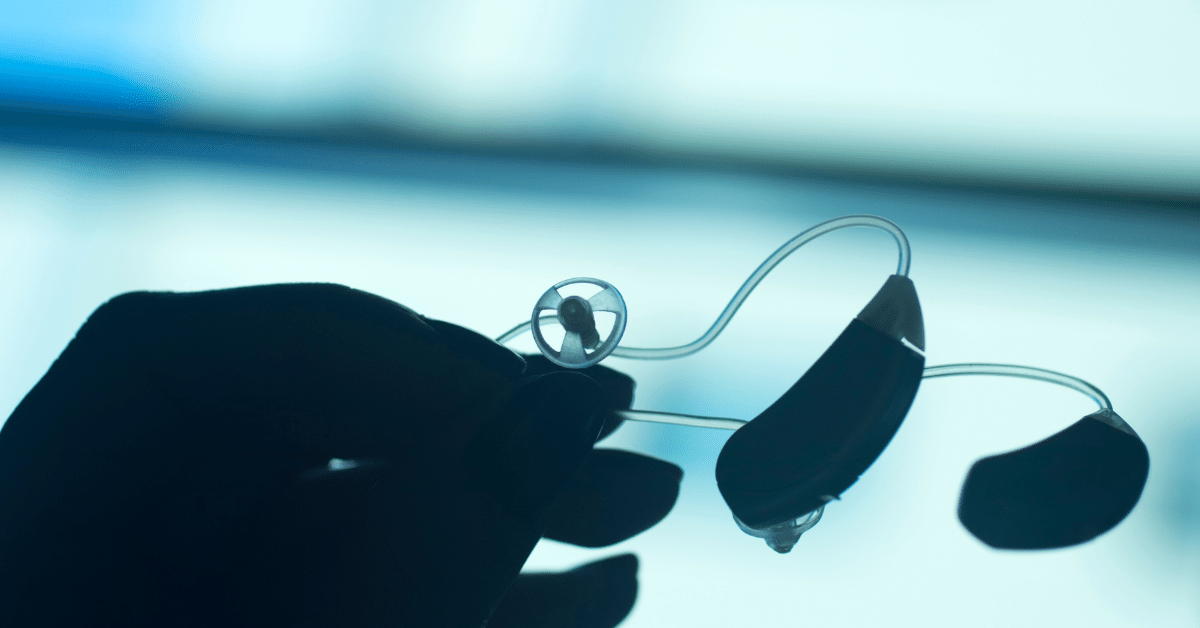Are you looking for the best possible way to hear everything? Look no further—we’ve got the perfect solution for you: a Bluetooth hearing aid! With this device, you can enjoy crystal-clear sound and stay connected to your world at the same time. Whether you need it for work or pleasure, this will become your go-to gadget in no time. Keep reading to find out why!
Introduction to Bluetooth Hearing Aids
Bluetooth hearing aids are revolutionary devices that offer superior audio performance and outstanding connection capabilities. While traditional hearing aids can be connected to other devices using cables or special attachment pieces, Bluetooth hearing aids are equipped with a built-in receiver that uses wireless radio frequency connection to “talk” between devices. This type of connection allows Bluetooth hearing aid users to control volume and sound settings, view battery life and interface with all types of compatible streaming technology.
The first widely available Bluetooth hearing aid was introduced in 2013 and has since made advancements in audio quality, battery life, size, features and convenience. Nowadays these sophisticated and powerful devices are able to produce unparalleled sound with enhanced clarity and accuracy while connecting seamlessly with all types of electronic equipment like phones, computers, tablets, TVs and more. Additionally, more recent versions of Bluetooth Hearing Aids come equipped with sophisticated noise canceling technology for even better user experiences.
Bluetooth Hearing Aids are a great choice for those looking to increase their hearing ability without having any extra wires or attachments restricting them from accessing their favorite music or communication tools effectively. By incorporating superior wireless content streaming properties with enhanced revolutionary sound enhancement technologies these cutting-edge devices have become the premier choice for many individuals experiencing mild-to-moderate hearing loss throughout the world today.
Benefits of Bluetooth Hearing Aids
Bluetooth hearing aids are the latest development in hearing technology. They allow users to stream audio directly from compatible devices, like smartphones or tablets, to their hearing aid. This eliminates the need for extra cables and accessories, and provides a discreet, convenient listening experience. Additionally, some Bluetooth hearing aids offer features like noise cancellation and can be conveniently adjusted using a smartphone app.
Bluetooth hearing aids make it easier for many people with hearing loss to communicate with friends and family on the phone or in person. They can also provide enhanced sound quality when watching movies and listening to music. Newer Bluetooth models may even be able to access internet-based streaming services so users can listen to podcasts, audiobooks and more at their leisure.
The advantages of Bluetooth hearing aids extend beyond convenience; they also offer improved listening outcomes for many patients with advanced levels of loss from different types of technologies (e.g., directional microphones). The added connectivity makes conversations quieter by reducing background noise significantly, while ensuring that voices are heard clearly. Furthermore, using multiple devices via Bluetooth simultaneously is possible as newer devices provide simultaneous streaming support. With different settings configured precisely for specific needs like one-on-one conversations or noisy social events, Bluetooth hearing aid wearers enjoy greater comfort and auditory clarity than ever before!
Types of Bluetooth Hearing Aids
There are three types of Bluetooth hearing aids available: Behind-the-Ear (BTE), In-the-Ear (ITE), and Receiver-in-Canal (RIC).
Behind-the-Ear hearing aids sit behind the ear and have a tube that runs down to fit inside of the ear. The tube can be changed out for different sizes depending on the user. These are usually the most customizable and provide more amplification than other types.
In-the-Ear hearing aids have a cast made from an impression taken of your ear, then a special metal piece is created to fit over that cast. This type is discrete but it is not as adjustable as BTEs.
Receiver in Canal hearing aids come in a variety of shapes, but all have small components that fit inside your ear canal and work wirelessly with external elements like microphones or remotes that can be used for adjusting volume and sound settings. They are very discrete, light in weight, and tuck up nicely into the bowl of the ear so they are less noticeable than other types.
How to Choose the Best Bluetooth Hearing Aid
Choosing the right hearing aid can seem like a daunting task. There is a wide range of quality and types available, from conventional analog devices to cutting-edge digital solutions. When it comes to Bluetooth hearing aids, there are a few key factors to consider.
First, you want to determine your own hearing needs. Ask yourself questions about your lifestyle and level of hearing difficulty – what type of activities you participate in, how severe your hearing issues are, and which types of sound environments you encounter most often? Taking the answers into account will help you decide what type of device is best suited for your needs.
Once you have determined your own specific requirements, it’s time to start looking at device features. Not all Bluetooth hearing aids come with all the same features or specs; some may have better range or reception than others, while some may even come equipped with special noise cancellation capabilities or enhanced audio clarity settings tailored to particular environments. It’s essential to narrow down what features matter most before continuing on with the selection process.
When choosing a Bluetooth Hearing Aid make sure it includes pairing capability with most electronic devices. This consideration can be especially important if you enjoy streaming audio from your smartphone or playing podcasts on other devices while out and about. Also be aware that some Bluetooth hearing aids provide additional compatibility with Apple products such as Siri support – this might be a terrific bonus if using an iPhone as part of your daily routine.
Finally, researching consumer feedback and pricing can give an idea on cost effectiveness as well as potential sound quality for each model being considered for purchase – these ratings can help narrow the field further and identify the best choice for individual users’ specific needs.
Top 10 Bluetooth Hearing Aids in 2025
- Cutting-Edge Sound Experience🌟 – Immerse yourself in crystal-clear sound quality with our state-of-the-art 25-channel Bluetooth HD hearing aid,…
- 📱 Seamless Connectivity & Hands-Free Convenience Compatible with iOS 12 or later and Android 9 or later — Bluetooth connection has been tested…
- 🎶 Smart Hearing, Clear Expectations Enjoy intelligent sound personalization with our app’s self-fitting feature. Just take a quick in-app…
- Wireless Connectivity: With the built-in 5.3 Bluetooth technology, you can easily connect your hearing aids rechargeable to your smartphone,…
- Adaptive Noise Reduction: The intelligent chip embedded in the hearing aids continuously detects and analyzes the surrounding noise environment,…
- High-Quality Audio: Our hearing aids utilize advanced digital signal processing technology to deliver clear and realistic sound quality. Whether…
- Fashionable Appearance : The design is more fashionable and trendy, and it is difficult to notice that it is a hearing aid when wearing it on the…
- Hearing aid Bluetooth 2 in 1 : Breaks the traditional single hearing aid mode, innovative combination of Bluetooth mode, upgraded and optimised the…
- APP Custom Demand : Hearing aids for seniors equipped with APP intelligent program, personalised custom to meet different needs. Hearing fitting to…
- Hear What Matters, Forget the Rest: Tired of asking, “What?” in conversations? The Audien Atom Pro 2 is here to put an end to those confusing…
- Advanced Background Noise Cancellation: It’s time to say goodbye to distracting background noise. With the Atom Pro 2, hear every word with…
- 4 versatile Hearing Modes: Easily switch between 4 versatile hearing modes and start hearing your loved ones more clearly. Enjoy both the TV and…
- Restore Authentic Human Voices: Equipped with the Flaygo self-developed the newest digital chip, these hearing aids utilize adaptive noise…
- Powerful Battery Performance: This rechargeable hearing aid features intelligent charging algorithms to handle high currents safely to deliver…
- Comfortable Wearing: New and enhanced ear sleeves offer improved grip and all-day comfort without slippage. The super mini design provides an…
- High-Quality Audio Amplifier: Utilizes advanced audio amplification technology to provide clear and natural sound,The amplifier ensures equal sound…
- Bluetooth Hearing Aids: Equipped with built-in Bluetooth functionality, effortlessly connect to your smartphones, it is also support to music…
- Multiple Hearing Modes: This Hearing Amplifier features 4 adjustable hearing modes(High, Low, Mid, Wide)to cater to different listening…
- Extended Battery Life and Intelligent Noise Reduction⚡🌊 – Stay active and engaged with an impressive 192 hours of battery life in the charging…
- Extended Battery Life and Intelligent Noise Reduction⚡🌊 – Stay active and engaged with an impressive 192 hours of battery life in the charging…
- Extended Battery Life and Intelligent Noise Reduction⚡🌊 – Stay active and engaged with an impressive 192 hours of battery life in the charging…
- Wireless Connectivity: With the built-in 5.3 Bluetooth technology, you can easily connect your hearing aids rechargeable to your smartphone,…
- Adaptive Noise Reduction: The intelligent chip embedded in the hearing aids continuously detects and analyzes the surrounding noise environment,…
- High-Quality Audio: Our hearing aids utilize advanced digital signal processing technology to deliver clear and realistic sound quality. Whether…
- [True Digital Hearing Aids (Not Amplifiers) ]: our HA219 hearing aids combines 16-channel WDRC technology and dynamic DPS noise reduction Chip and…
- [ Bluetooth 5.3 Technology ]: Digital hearing aids comes with latest Bluetooth 5.3 technology , which is compatible with iOS and Andriod…
- [Rechargeable and LCD Power Display]: Hearing aids build-in magnetic charging case and only takes 1-2 hours to fully charged, enough to charge a…
Tips for Using Bluetooth Hearing Aids
Using Bluetooth hearing aids can provide you with exceptional convenience and sound quality. However, it’s important to ensure that you know the proper tips for using them in order to get the best results. Here are a few tips for using Bluetooth enabled hearing aids:
1. Make sure your smartphone or other source device is compatible with the Bluetooth protocol. Many modern smartphones include this protocol, but if not, you may need a system upgrade or adapter in order to enable connection to your device.
2. Ensure that there is line of sight between your device and Bluetooth hearing aid: as these operate via radio signals, they need an uninterrupted signal path in order to work properly. This means that any physical obstruction – such as walls or furniture – may interfere with digital options like streaming music from a smartphone device directly into the hearing aids.
3. Keep digital protocols such as Wi-Fi disabled on all devices when using your Bluetooth enabled hearing aids as this may cause interference problems resulting in audio lag or sound distortion when streaming audio content into the hearing aids. Likewise, enabling too many audio sources at once – such as having both Wi-Fi and a headset activated – could also create an audio conflict, so be sure to manage your sources properly in order to prevent any potential snags while listening via wireless mode.
4. Make sure that both your device and headphones feature volume management options – such as automatic maximum limit settings – in order prevent loud volume levels inadvertently damaging the sensitive components of either product. High decibel levels can render hearing aid components defective over time due to excess strain being placed on them – so make sure you take proper care when setting up digital protocols for safe listening parameters according to user preference!
Common Issues with Bluetooth Hearing Aids
Bluetooth hearing aids connect to compatible devices, like smartphones, with Bluetooth technology. This connection can provide various levels of listening help, such as a better sound quality when speaking on the phone or streaming audio content straight to the hearing aid. While this technology is growing in popularity, there are some common issues that people using Bluetooth hearing aids may experience.
The first issue is a lack of compatibility with other devices. For example, only certain phone models may be able to pair with Bluetooth hearing aids. Additionally, some hearing aids are only compatible with certain manufacturers and brands. This can limit a user’s access to particular apps or features on their device.
Another frequent problem relates to pairing and connecting the device in all different types of environments and locations. This could include dealing with noisy backgrounds or weak signal connections which interfere between the two devices leading to problems like limited range and sound degradation from static noise in the connection.
Finally, many people struggle with understanding all features their device offers and configuring settings correctly to get the best sound quality out of their aid. Understanding all buttons on the device might seem overwhelming at first but taking time to learn how each one works will be beneficial in long run since users can personalize settings that work best for them individually and get most out of their devices functionality.
How to Maintain Bluetooth Hearing Aids
Bluetooth hearing aids use wireless technology to stream sound from a variety of different devices directly to your ears. This makes it possible for you to have a discreet, customized and active listening experience that is far more comfortable than traditional options like bulkier amplifiers or headphones. It is important to take the time to maintain your hearing aids in order to ensure that they continue working properly and provide you with a reliable listening experience.
There are several steps that need to be taken in order to properly care for Bluetooth hearing aids:
1. Clean Your Hearing Aids – This can vary depending on the type of hearing aid you have, but it is generally recommended that you clean them every day after wearing them with a soft, dry cloth. Avoid using any alcohol-based cleaning agents and never submerge them in water as this can damage their components and wiring.
2. Store Them Properly – When not using them, the optimal storage environment for these devices will be away from direct sunlight and extreme temperatures where humidity is at moderate levels, such as in your bedroom drawer or case provided by the manufacturer. To prevent damage from dust, pet hair or other airborne particles, place a small bag over each one before storing them away when not in use – this will also help keep them looking better during travels as well!
3. Minimize Exposure To Moisture – You should always make sure that your bluetooth hearing aid is kept at least 4 feet away from any source of moisture such as bathrooms, showers areas or pools; naturally occurring body fluids such as sweat can also contribute toward moisture issues if left unchecked so it’s important to keep wiping your hands if they become damp while wearing the device throughout the day of use.
4. Change The Batteries Regularly – For optimal performance it’s advised that you change out its batteries on a regular basis depending on factors like battery type (for rechargeable versions) or usage frequency (for disposable types). Most manufacturers recommend changing their rechargeable batteries every 3 months so check their individual instructions before taking any action with regards this concern!
5. Schedule Professional Checks & Adjustments- In addition to everyday checks at home it’s essential that you schedule professional checks and adjustments according with your provider’s guidance in order for Bluetooth devices work properly; often times these checks may require changes within settings based on individual lifestyle needs – make sure consult with someone qualified about adjusting accordingly as soon possible if needed in order avoid potential frustration down line!
Conclusion
The best Bluetooth hearing aid is the one that fits your hearing needs and lifestyle. Comfort, convenience, and sound quality should be taken into consideration when shopping for a Bluetooth hearing aid. While price is always important, it is not the only factor to consider when choosing a Bluetooth hearing aid. Whether you are looking for a discreet model or want to take advantage of the latest wireless technology, there are many options out there to meet your needs.
Do your research to make sure you pick the right product for you and explore features like automatic program presets, direct streaming from mobile devices, remote control options, and adjustable EQ settings. Additionally, look for long battery life and any special features like voice-recognition or swipe controls that will make using your hearing aid more comfortable and enjoyable.
Top 10 Best Best Bluetooth Speakers for Motorcycles 2025
Set Sail with the Best Bluetooth Speakers for Boats 2025
Best Bluetooth Headset for Truckers 2025
Communicate Clearly with the Best Bluetooth Speakerphone in 2025













